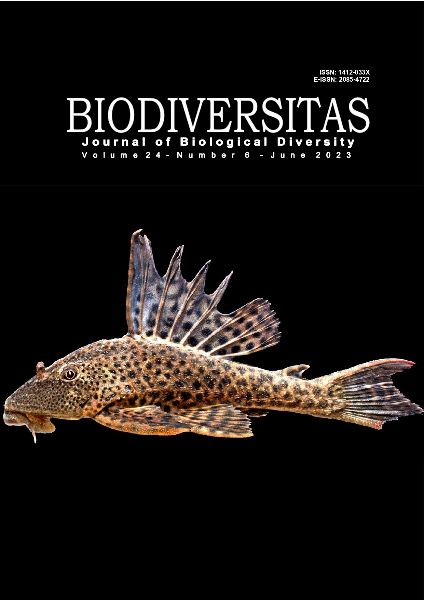Diversity of epiphytic bryophytes in Medan City Parks, North Sumatra, Indonesia and its potential as lead (Pb) bio-accumulators
##plugins.themes.bootstrap3.article.main##
Abstract
Abstract. Siregar ES, Pasaribu N, Lubis AF. 2023. Diversity of epiphytic bryophytes in Medan City Parks, North Sumatra, Indonesia and its potential as lead (Pb) bio-accumulators. Biodiversitas 24: 3214-3221. The information on the diversity of epiphytic bryophytes in the metropolitan area, particularly Medan City, North Sumatra, Indonesia has been limited. Therefore, this study aimed to conduct an inventory of the diversity of epiphytic bryophytes in Medan City parks as well as to assess their potential as lead (Pb) bioaccumulators. Three sampling sites, namely Ahmad Yani Park, Beringin Park, and Medan Zoo, were selected based on their pollution levels from high to low, respectively. Five plots with dimensions of 25×25 m were placed at each site and five representative host trees were selected in each plot. Lead (Pb) bioaccumulation of bryophyte samples is determined using the atomic absorption spectroscopy (AAS) method at the Plant Research Center Laboratory, Medan. The Pb-bioaccumulation capacity of each species from different sites was compared through two-way ANOVA. The results showed eight species, namely four liverworts (Marchantiophyta): Cololejeunea lanciloba Steph., Lejeunea cocoes Mitt., Lopholejeunea eulopha (Taylor) Schiffn., and Lopholejeunea subfusca (Nees) Schiffn., as well as 4 Mosses (Bryophyta): Calymperes tenerum C.Müller, Meiothecium microcarpum Mitten, Octoblepharum albidum Hedwig and Vesicularia dubyana Brotherus. Vesicularia dubyana was the dominant species at Beringin Park and Medan Zoo, while C. tenerum was dominant at Ahmad Yani Park. The biodiversity of epiphytic bryophytes in this study was categorized as moderate level (1?H’?3). The highest Important Values Index (IVI) of epiphytic bryophytes in this study was obtained for V. dubyana at 131.80. The highest Pb bioaccumulation was observed in O. albidum at 87.5 mg/kg, followed by V. dubyana at 66.6 mg/kg. This study provided information on the ecological contribution of epiphytic bryophytes as Pb bioaccumulators in urban areas. Vesicularia dubyana and O. albidum can be recommended as biomonitoring agents in the future.

